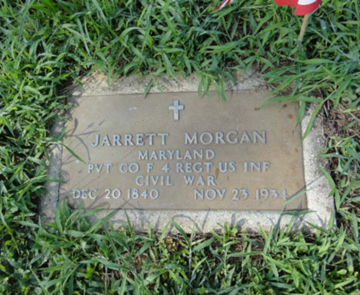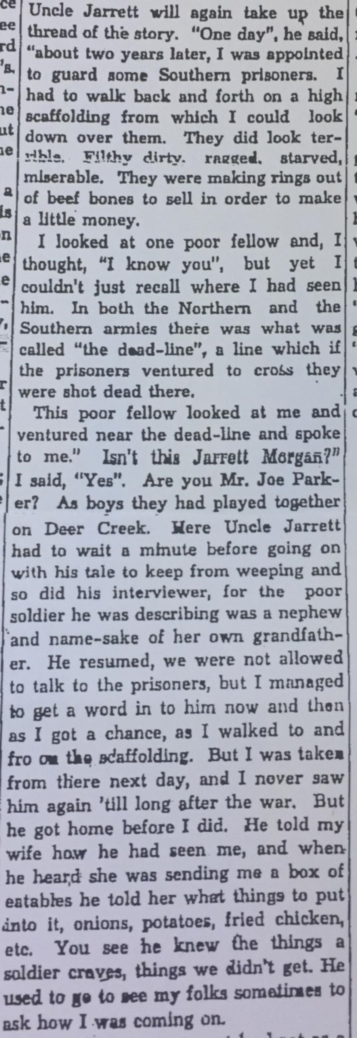The Reminiscences of a Union Prison Guard

As a special part of this year’s Fourth Annual Emerging Civil War Symposium at Stevenson Ridge, we’re pleased to welcome Dr. Kelly D. Mezurek, a member of ECW’s “Engaging the Civil War” Series editorial board and author of A Cause of Their Own: The 27th United States Colored Troops. Although the overall theme of the Symposium is “Great Defenses of the Civil War,” Kelly will be offering a special Friday-evening program on the U.S.C.T. (just because we wanted to mix things up a little bit!).
Today, Kelly shares with us one of the stories she uncovered during her research.

While researching for a chapter on African American soldiers who served as guards at Union prisons during the Civil War, I came across the words of Jarrett Morgan, a member of the United States Colored Troops (USCT). I was excited to find the private’s account of his time at Point Lookout, Maryland, as I hoped to include the experience of black soldiers through their own words in ‘“De Bottom Rails on Top Now’: Black Union Guards and Confederate Prisoners of War” (forthcoming in Civil War Prisons II, edited by Michael P. Gray, Kent State University Press). Wanting more information, I sought out the primary source of Morgan’s story used by Edward G. Longacre in A Regiment of Slaves: The 4th United States Infantry, 1863-1866.
Longacre, a gracious and generous historian whose work provided me with my earliest scholarly encounters with the USCT, put me in contact with Morgan’s descendant, Darlene Dorman. Through email correspondence, Dorman and I have since exchanged information on Jarrett Morgan, who resided in Harford County, Maryland, before and after the war. And most importantly, she shared a copy of the 1934 newspaper article, “Jarrett Morgan and His Reminiscences of Civil War Days,” the source for his account about Point Lookout.
In April 1864, Benjamin F. Butler ordered the 4th United States Colored Infantry (USCI) to St. Mary’s County, Maryland, to join the other Union troops stationed there, both black and white, to picket along the shores of the peninsula, provide the labor needed to build, repair, and maintain the buildings and stockades on the grounds, and to serve as guards over Confederate prisoners at Camp Hoffman. The Commissary General of Prisons, Bvt. Maj. Gen. William Hoffman, had the prison camp built on the peninsula at the confluence of the Chesapeake Bay and Potomac River soon after the prisoner exchange cartel faltered. Most referred to the prison as Point Lookout.
Newspapers from the North and South reported on Butler’s use of black guards. Editors explained to their readers that he did so to punish Confederate leaders who refused to exchange captured USCT, by forcing Southern prisoners of war to face “the pleasure of being guarded by bayonets in negroes’ hands.” The Liberator printed the claim that all prisoners held in Butler’s department would suffer “under the guard of colored troops.”
Jarrett Morgan shared a less hostile account of his experiences as a Union prison guard. In his 1932 interview, compiled only six months before his death, he remembered how he pitied the imprisoned men. He recounted how when he looked down upon the white men as he walked across the platform that he had thought of them as “terrible. Filthy dirty, ragged, starved, miserable” beings who undoubtedly suffered from their circumstances. Although it was forbidden, one day he spoke with one of the rebels and was surprised to learn that the prisoner was a childhood acquaintance. Although Morgan thought he might try to help the man, he “never saw him again ‘till long after the war.” But when the Confederate soldier returned to Harford County prior to Morgan’s muster out, he visited Morgan’s wife and shared what news he had about Morgan, and returned several times to hear if Morgan’s family had heard anything else about the wellbeing of the black soldier.

Although the lengthy reminiscence provides a rare firsthand account of an African American soldier’s experiences of serving as a guard over white Southern prisoners of war, the newspaper clipping raises many questions. For example, why did Jarret Morgan share such a sympathetic version of his Civil War era experiences related to local white residents? It is possible that he was being polite to his interviewer, Jeanette Parker, because the prisoner he had met at Point Lookout was related to her grandfather. But the more likely reason was that “the only surviving colored soldier of the Union Army in Harford County” understood that his precarious position within his Maryland community would be threatened if he shared an unflattering memory. Also the photocopy of the article does not include the newspaper title or date, only the handwritten words, “May 3, 1934 Record Times.” A search through the Library of Congress website, “Chronicling America,” fails to provide information on a newspaper with that name. In its list of newspapers, the Maryland State Archives, Guide to Special Collections, provides one potential publication that might have run the article. The Bel Air Times (Bel Air, Harford County, Maryland, 1881-1941) was preceded in the mid-1800s by the Bel Air Record.
Darlene Dorman came to my rescue once again, sharing that “Through a family member I was introduced to a Harford County genealogist/historian. As we discussed African-American history in Harford Co, his work in that area and my own family research, he recalled having a copy of this article. How ironic the subject of the article was one of my ancestors. This is a copy of the article he provided to me and it is his handwriting at the bottom noting date of publication and the newspaper. I have visited the Harford County Historical Society where some of the county newspapers are archived and have seen the actual article. The Record Times has long since been absorbed into another newspaper making it quite the challenge to locate the original article.”
One of the most gratifying outcomes I receive from researching the USCT, as soldiers and as veterans, is the opportunity to connect with descendants and other researchers, both academic and public historians. While digitization projects have increased our access to the primary sources related to black Civil War soldiers, a significant amount of information remains in the hands of families, genealogists, and local historians; we will all benefit if we connect more in our research processes. Furthermore, the story of Jarrett Morgan’s experiences at Point Lookout does more than expand our understanding of Civil War prisons. It also reminds us how the impact of the war differed for people North and South, white and black, and how those differences continue to present themselves today.
————
Order your tickets today to the Fourth Annual Emerging Civil War Symposium at Stevenson Ridge, Aug. 4-6, 2017.